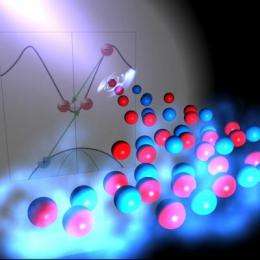Terahertz pulse increases electron density 1,000-fold

Researchers at Kyoto University have announced a breakthrough with broad implications for semiconductor-based devices. The findings, announced in the December 20 issue of the journal Nature Communications, may lead to the development of ultra-high-speed transistors and high-efficiency photovoltaic cells.
Working with standard semiconductor material (gallium arsenide, GaAs), the team observed that exposing the sample to a terahertz (1,000 gigahertz) range electric field pulse caused an avalanche of electron-hole pairs (excitons) to burst forth. This single-cycle pulse, lasting merely a picosecond (10-12 s), resulted in a 1,000-fold increase in exciton density compared with the initial state of the sample.
"The terahertz pulse exposes the sample to an intense 1 MV/cm2 electric field," explains Hideki Hirori, team leader and Assistant Professor at Kyoto University's Institute for Integrated Cell-Material Sciences (iCeMS). "The resulting exciton avalanche can be confirmed by a bright, near-infrared luminescence, demonstrating a three-order of magnitude increase in the number of carriers."
Research in Kyoto using terahertz waves is led by Professor Koichiro Tanaka, whose lab at the iCeMS pursues numerous applications including the development of new biological imaging technologies.
"Since terahertz waves are sensitive to water, our goal is to create a microscope that will allow us to look inside living cells in real time," says Prof. Tanaka. "These just-released results using semiconductors are an entirely different field of science, but they demonstrate the rich potential that lies in the study of terahertz waves."
More information: The article, "Extraordinary carrier multiplication gated by a picosecond electric field pulse" by H. Hirori, K. Shinokita, M. Shirai, S. Tani, Y. Kadoya, and K. Tanaka was published online in the December 20, 2011 issue of Nature Communications.
Journal information: Nature Communications
Provided by Kyoto University

















